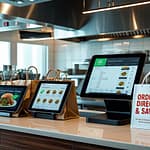Key Takeaways:
- Incorporate AI-based tools in your restaurant to enhance customer service and streamline operations, one of the top tech trends in 2025.
- Invest in smart kitchen appliances for improved efficiency and waste reduction, a major 2025 innovation.
- Utilize data analytics tools to optimize menu offerings, pricing strategies, and improve customer experiences.
- Implement mobile ordering and contactless payment solutions to meet customer expectations for convenient and safe dining.
- Explore virtual reality applications for immersive dining experiences, a cutting-edge restaurant tech trend in 2025.
Top 5 Restaurant Tech Trends of 2025
The biggest restaurant tech trends to watch
The restaurant industry is evolving rapidly, and technology sits at the forefront of this transformation. Remaining competitive in 2025 means embracing innovative solutions that enhance guest experiences, streamline operations, and boost profitability. From artificial intelligence to sustainable technology, restaurant tech trends are reshaping the way restaurants operate and interact with their customers. Here, we explore the top five restaurant tech trends of 2025 that every F&B business should consider.
1. AI-Powered Personalization and Guest Experience
Artificial intelligence (AI) continues to redefine how restaurants interact with their customers. By 2025, AI-driven personalization will become commonplace, offering tailored dining experiences based on customer preferences, past orders, and even dietary restrictions. Restaurants employing AI-driven personalization can expect higher customer satisfaction, repeat visits, and increased revenue.
Actionable Advice for Restaurants:
- Invest in AI-driven customer relationship management (CRM) systems to capture and analyze guest data.
- Utilize AI-driven recommendations on digital menus or apps to upsell dishes based on customer history.
- Train staff to leverage AI insights to enhance in-person dining experiences.
Industry Example:
Global brands such as Starbucks are already pioneering AI-driven personalized experiences. Starbucks leverages AI technology via its mobile app, providing personalized recommendations, customized promotions, and targeted rewards programs to boost customer loyalty.
2. Automated and Robotics-Enhanced Kitchens
Automation and robotics are no longer futuristic concepts—they are becoming practical solutions for restaurants looking to increase efficiency and consistency. Robotic kitchen assistants and automated cooking appliances can streamline food preparation, reduce human error, and improve overall consistency in food quality.
Actionable Advice for Restaurants:
- Integrate automated kitchen equipment gradually, starting with repetitive tasks such as frying, grilling, or food preparation.
- Assess kitchen workflows to identify areas where robotics can provide the most benefit.
- Train staff to collaborate effectively alongside automated systems to maximize efficiency.
Industry Example:
Chains like Chipotle and White Castle have already begun incorporating robotics into their kitchens. Chipotle has tested robotic tortilla chip preparation, while White Castle adopted robotic burger-flipping technology to enhance accuracy, reduce labor costs, and improve efficiency.
3. Enhanced Digital Ordering and Payment Solutions
In 2025, digital ordering and payment solutions will become even more sophisticated and widespread. From advanced mobile apps and self-ordering kiosks to integrated digital wallets and contactless payments, these innovations help restaurants streamline operations, reduce wait times, and enhance convenience for guests.
Actionable Advice for Restaurants:
- Upgrade digital platforms to offer seamless integration of online ordering, delivery, and payments.
- Implement self-service kiosks or QR-code ordering systems to optimize front-of-house operations.
- Adopt contactless payments and digital wallets to speed up checkout and enhance customer safety and convenience.
Industry Example:
Brands like Panera Bread have successfully implemented advanced digital ordering systems. Panera’s mobile app and in-store kiosks allow customers to customize, order, and pay effortlessly, significantly improving efficiency and customer satisfaction.
4. Data-Driven Sustainability and Environmental Responsibility
Environmental consciousness and sustainability will become major differentiators for restaurants in 2025. Technology will play a crucial role in helping restaurants track environmental impact, reduce waste, and optimize resource usage. Data-driven platforms can help businesses make more informed decisions about sustainable practices, from menu planning to waste management.
Actionable Advice for Restaurants:
- Use technology to track and analyze food waste patterns, enabling smarter purchasing decisions and portion control.
- Invest in digital inventory management systems that reduce spoilage and excess food ordering.
- Explore tech platforms that help measure and communicate your restaurant’s sustainability efforts to customers.
Industry Example:
Sweetgreen, a fast-casual chain renowned for its sustainability initiatives, leverages technology to reduce food waste and manage its supply chain efficiently. The brand uses cloud-based data analytics to predict food demand accurately, ensuring minimal waste and optimal inventory levels.
5. Immersive and Interactive Guest Experiences
Restaurants in 2025 will increasingly adopt immersive technologies like augmented reality (AR) and virtual reality (VR) to create unforgettable dining experiences. These innovative tools enable restaurants to engage customers in interactive storytelling, menu previews, and virtual culinary journeys, enhancing dining experiences beyond the traditional meal.
Actionable Advice for Restaurants:
- Consider implementing AR-enabled menus to allow guests to visualize dishes before ordering.
- Create immersive VR experiences that showcase the sourcing of ingredients, cooking processes, or restaurant history.
- Collaborate with tech developers to design customized interactive experiences aligned with your brand identity.
Industry Example:
Restaurants like Sublimotion in Ibiza have embraced immersive dining experiences through advanced VR and projection mapping. Guests at Sublimotion enjoy multi-sensory storytelling alongside culinary delights, creating a unique, memorable, and premium dining atmosphere.
Conclusion
As we move towards 2025, technology will continue to shape the restaurant industry dramatically. Embracing key restaurant tech trends such as AI personalization, kitchen automation, advanced digital ordering, sustainability analytics, and immersive experiences will help businesses stay ahead of the curve. Restaurant owners and managers who proactively adopt these innovations will be best positioned to enhance guest experiences, streamline operations, and achieve sustainable growth in an increasingly competitive F&B marketplace.






Comments
Be the first to comment on this article.